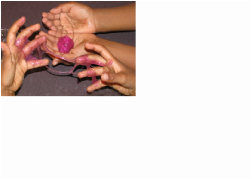Glowy, Slimy, Blood

Slime
Materials
1 cup tonic water
2 teaspoons Polymer
1 red plastic cup
Red food coloring
Materials from home
Microwave-safe bowl
Black light/Ultra violet light
How do I begin?
1. Stir one teaspoon polymer into the tonic water.
2. Add a drop or two of food coloring. The slime gets darker, so don't add too much food coloring.
3. Ask your adult helper to heat the liquid in a microwave-safe container until it boils/bubbles up. Depending on your microwave power this may be anywhere from 1-4 minutes. When the mixture boils, pause the microwave and stir the slime.
4. Cook the slime another 1-2 minutes. Stir it.
5. Repeat the cooking/stirring cycle a total of 4-5 times, or until the slime develops a gelatinous consistency. It will get more jelly-like once it cools.Remove the slime very carefully from the microwave. CONTAINER WILL BE VERY HOT!
6. Allow slime to cool off before you touch it. You can play or decorate with it.
7. Store your slime in a sealed bowl or Ziploc. If you are just decorating with it, it's fine at room temperature.
8. The slime won't stick to most surfaces, but the food coloring will stain fabrics and skin. Clean up slime with soap and water. Your favorite stain remover will take out the food coloring.
What just happened?
The polymer powder has cellulose which is soluble (disolves in liquid), so when you add it to tonic water and heat it, the solubility of the cellulose in the water increases. It speeds up the penetration of the water into the fiber pellets/particles. Once the the pellets break up, the chains of cellulose get a chance to "spread out" or "stretch" in the water phase. Eventually, if their concentration is high enough, chains come into contact with other chains, creating a loose-knit "network" of polymer chains in the water.
The slime glows blue-white under a black light/ultraviolet light. The glow is fluorescence from the quinine in the tonic water.
1 cup tonic water
2 teaspoons Polymer
1 red plastic cup
Red food coloring
Materials from home
Microwave-safe bowl
Black light/Ultra violet light
How do I begin?
1. Stir one teaspoon polymer into the tonic water.
2. Add a drop or two of food coloring. The slime gets darker, so don't add too much food coloring.
3. Ask your adult helper to heat the liquid in a microwave-safe container until it boils/bubbles up. Depending on your microwave power this may be anywhere from 1-4 minutes. When the mixture boils, pause the microwave and stir the slime.
4. Cook the slime another 1-2 minutes. Stir it.
5. Repeat the cooking/stirring cycle a total of 4-5 times, or until the slime develops a gelatinous consistency. It will get more jelly-like once it cools.Remove the slime very carefully from the microwave. CONTAINER WILL BE VERY HOT!
6. Allow slime to cool off before you touch it. You can play or decorate with it.
7. Store your slime in a sealed bowl or Ziploc. If you are just decorating with it, it's fine at room temperature.
8. The slime won't stick to most surfaces, but the food coloring will stain fabrics and skin. Clean up slime with soap and water. Your favorite stain remover will take out the food coloring.
What just happened?
The polymer powder has cellulose which is soluble (disolves in liquid), so when you add it to tonic water and heat it, the solubility of the cellulose in the water increases. It speeds up the penetration of the water into the fiber pellets/particles. Once the the pellets break up, the chains of cellulose get a chance to "spread out" or "stretch" in the water phase. Eventually, if their concentration is high enough, chains come into contact with other chains, creating a loose-knit "network" of polymer chains in the water.
The slime glows blue-white under a black light/ultraviolet light. The glow is fluorescence from the quinine in the tonic water.

